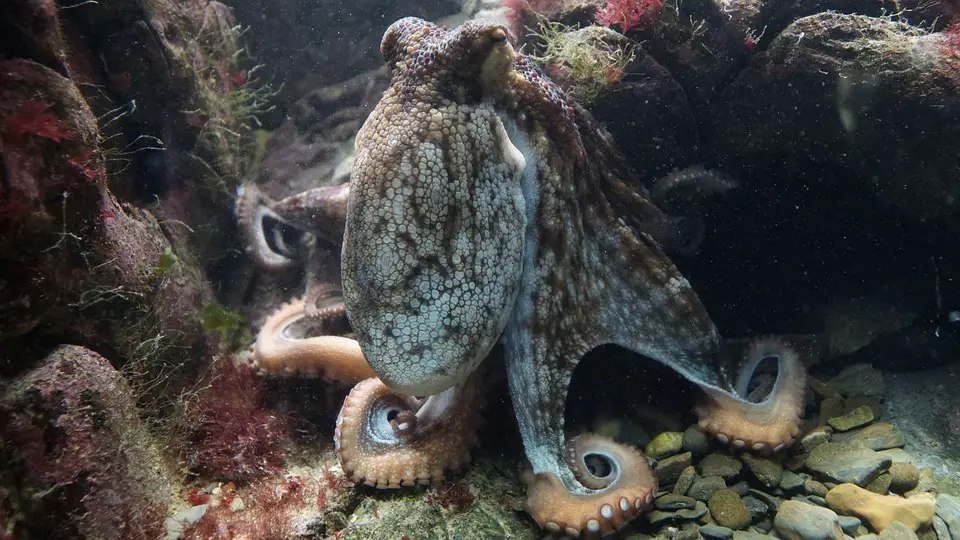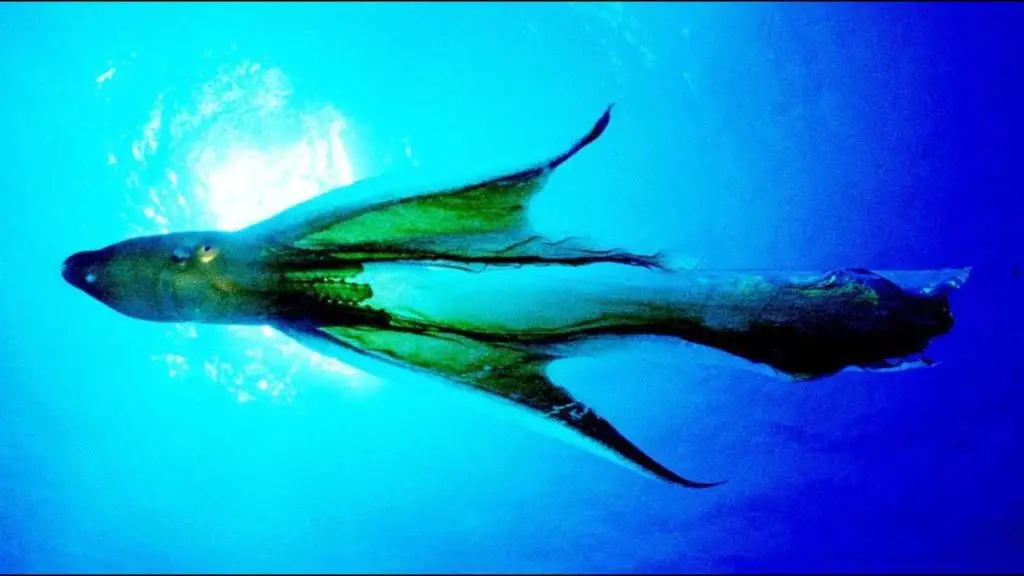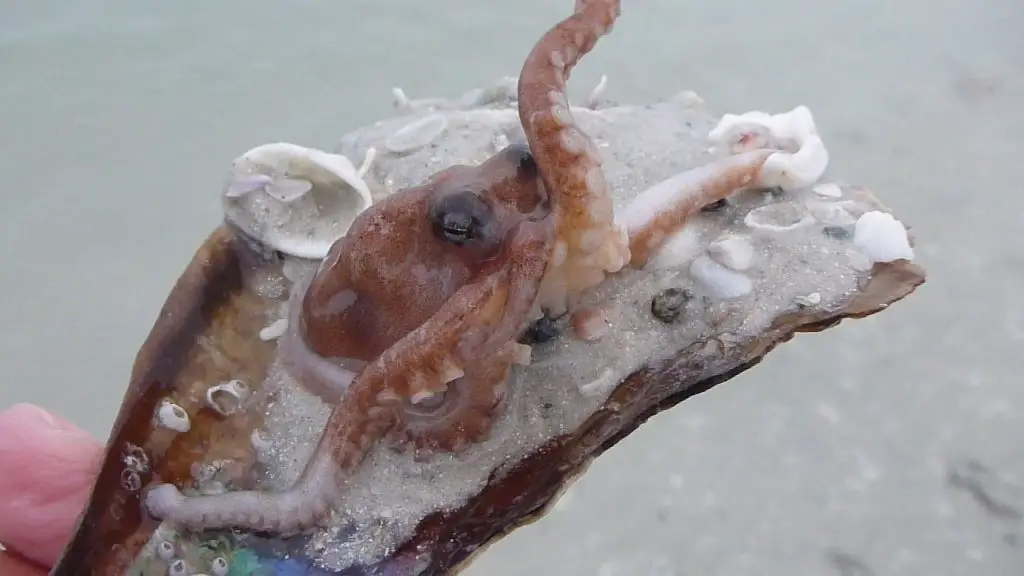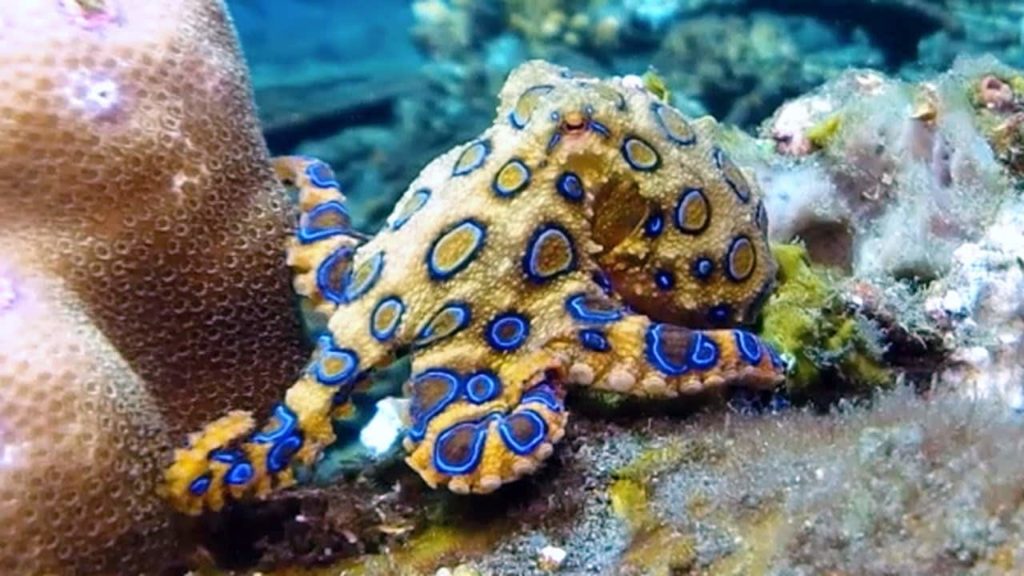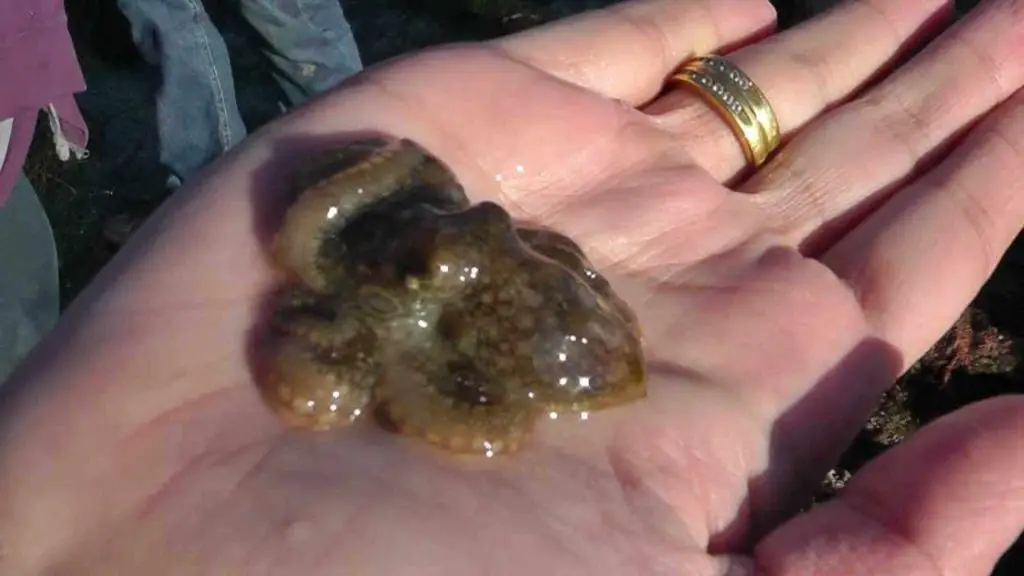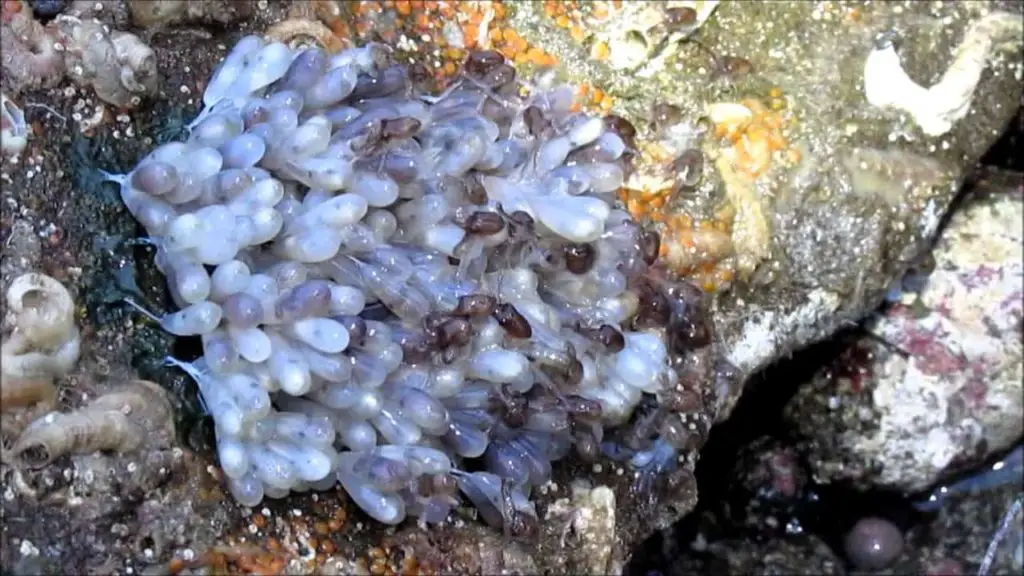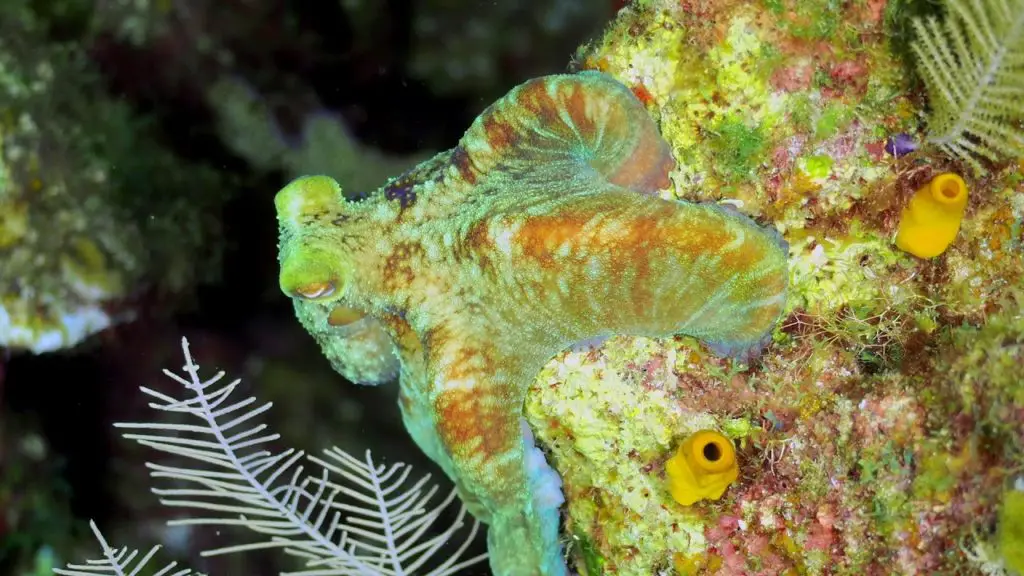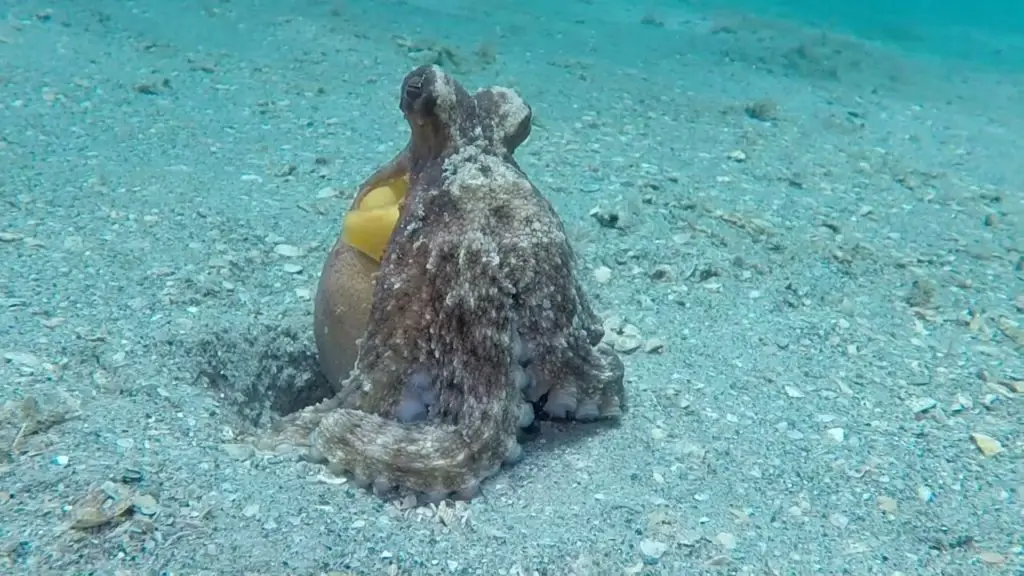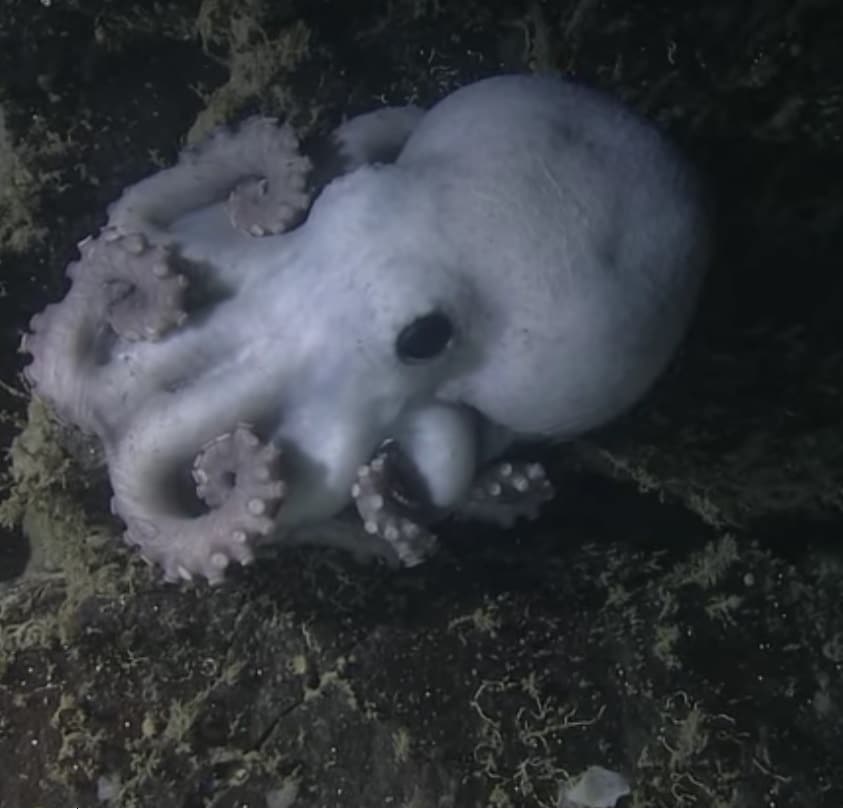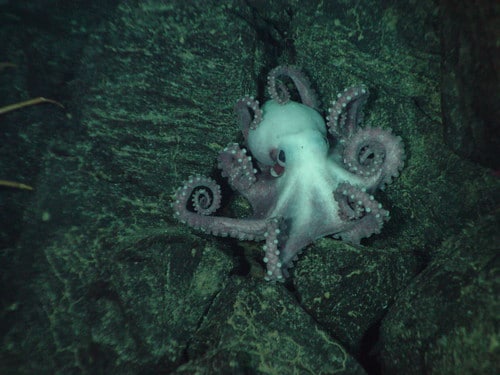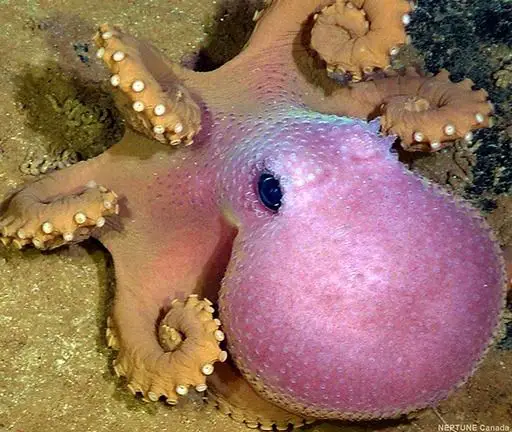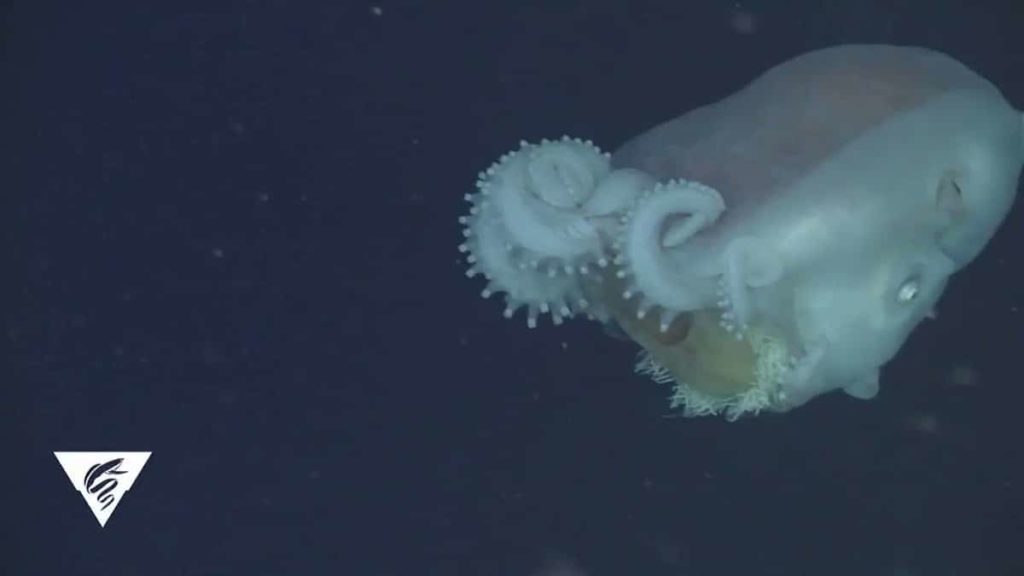There are 15 main types of octopuses. These include species like the blue-ringed octopus, dumbo octopus, blanket octopus, and giant octopuses. Each of the different types of octopus can be placed into two categories, finless, shallow water, and finned, deep water.
- Finless, Shallow-Water Octopus:
One of the main types of octopus is the finless, shallow-water octopus. These kinds of octopuses live around coral reefs and, of course, where the waters are shallow.
- Finned, Deep-Water Octopus:
These species of octopus, the finned, deep-water octopus, live in deeper waters, sometimes miles under the ocean.
Contents
Main Types of Octopus – Lower Classifications
Blanket Octopus
Blanket octopuses are so named because of the transparent webs that connect the dorsal and dorsolateral arms. Females can be more than six feet long, while the males are about the size of a walnut.
- Scientific name: Tremoctopus
- Rank: Genus
- Higher classification: Tremoctopodidae
- Phylum: Mollusca
- Order: Octopus
- Kingdom: Animalia
Atlantic Pygmy Octopus
These are the smallest species of octopus discovered so far by scientists. They weigh just over 1 ounce when fully grown.
- Scientific name: Octopus joubini
- Rank: Species
- Higher classification: Smoothskin octopus
- Phylum: Mollusca
- Class: Cephalopoda
- Order: Octopoda
Blue-Ringed Octopus
The blue-ringed octopus is a poisonous species of octopus that generally lives in tide pools and coral reefs in the Pacific and Indian oceans. Their range extends from Japan to Australia.
These octopus types are poisonous. A single blue-ringed octopus bite delivers a venomous neurotoxin 1000 times more powerful than cyanide. That means that, though the blue-ringed octopus is only the size of a golf ball, it still carries enough poison to kill 26 humans in minutes.
- Scientific name: Hapalochlaena
- Class: Cephalopoda
- Order: Octopoda
- Phylum: Mollusca
- Rank: Genus
Argonaut
The paper nautilus or Argonaut is usually found near the surface of tropical and subtropical seas. They feed mostly on plankton. These types of octopus are some of the few that have external shells.
California Two-Spot Octopus
The California Two-Spot octopus has two circular blue spots on the side of its head which distracts prey from their real eyes on their mantle.
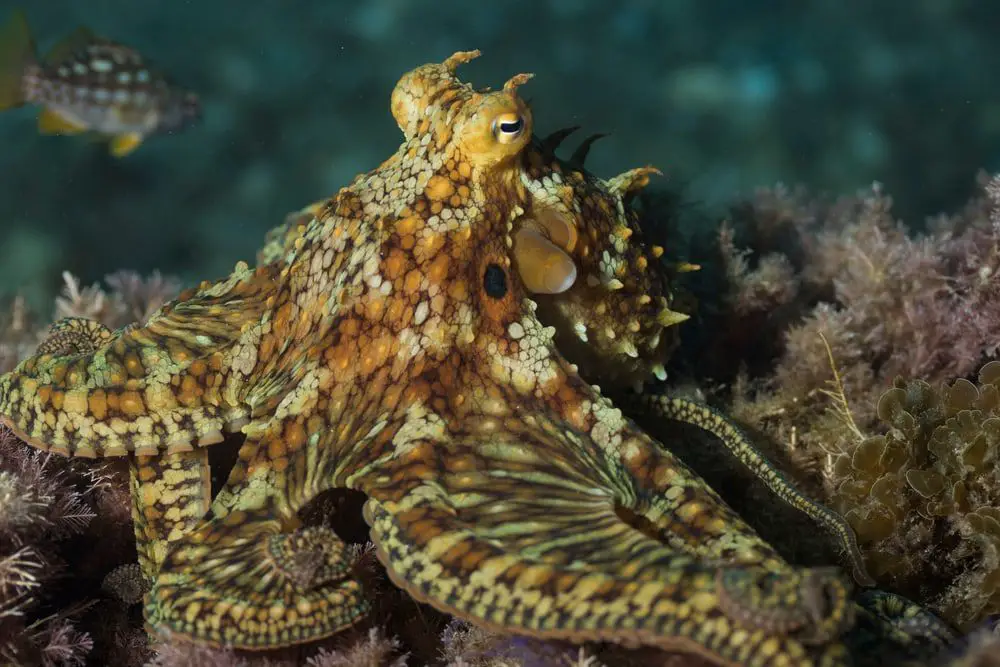
The typical lifespan of the California two-spot octopus is about one or two years. Once a female lays her eggs she dies soon after they hatch. Fun fact, the first octopus to have its genome sequenced was a California two-spot octopus.
Caribbean Reef Octopus
Caribbean reef octopuses are coral marine animals. They have 8 long arms each of which varies in length. Their mantles can be up to 60 cm long and are usually large and chunky.
This species of octopus is difficult to describe because it changes color and texture to blend into its surroundings, using specialized skin cells known as chromatophores.
Its color range is very large; it can change from crimson to green, and can even change its texture from bumpy to smooth. It weighs around 3.3 lb or 1.5 kg. Octopus briareus is one of the if not, the most intelligent of all invertebrates. It’s as smart as some types of mammals.
Cirrina
Cirrina or Cirrata have two small fins on their head and are only found in deep waters. They have a small internal shell and their suckers have “cirri” filaments. These fragments are believed to help octopus trap food.
Incirrata
Incirrata (or Incirrina) do not have an internal shell like their cousins (cirrata). Nor do they have cirri on their suckers or fins on their head.
Common Octopus
Octopus Vulgaris or the common octopus is the most studied octopus species in existence. Its appearance is unique because of its huge bulbous head, large eyes, and 8 peculiar tentacles. The common octopus grows up to 4.3 feet in length and can weigh up to 22 pounds.
Training experiments show that the common octopus can distinguish the brightness, size, shape, and horizontal or vertical orientation of objects.
East Pacific Red Octopus
The East Pacific red octopus is also known as the ruby octopus. The scientific name is octopus rubescens. These octopuses live in shallow-waters along the North American west coast.
In 2012, a tiny juvenile East Pacific red octopus made its way into the Monterey Bay Aquarium on a sponge, and hid in one of the exhibits for a year before being discovered walking across the Aquarium’s floor in the middle of the night.
Mimic Octopus
The mimic octopus is a species of octopus that has the ability to impersonate other local species of octopus.
They are known also known to mimic other animals (eel, starfish, jellyfish, and stingrays) in order to avoid detection by predators.
The mimic octopus was first discovered off the coast of Sulawesi, Indonesia by a group of scientists in 1998 on the bottom of a muddy river.
Megaleledonidae
Not much is known about Megaleledonidae. They are small species of octopuses rarely seen.
Giant Octopuses
The giant Pacific octopus is the largest of the different kinds of octopuses. It also lives longer than any other octopus species. The largest giant octopus recorded is held by a specimen that was 30 feet across and weighed more than 600 pounds. Giant Pacific octopuses are fished off of the coasts of North America and Japan.
Seven-Arm Octopus
Male seven-armed octopuses lack a tentacle because, the hectocotylus, the modified arm, is used for egg fertilization. It is coiled within a sac beneath the right eye of the octopus. The seven-armed octopus, Haliphron atlanticus, has only been observed by MBARI’s remotely operated vehicles three times in 27 years.
Dumbo Octopus
The dumbo octopus gets its name due to its resemblance to the Disney character from the film Dumbo. Their fins resemble large ears and extend from the mantle of the octopus above each eye.
Though they spend much of their lives suspended above the seafloor, dumbo octopuses lay their eggs on the bottom of the seafloor, attached to rocks or other hard surfaces.
Mosaic Octopus
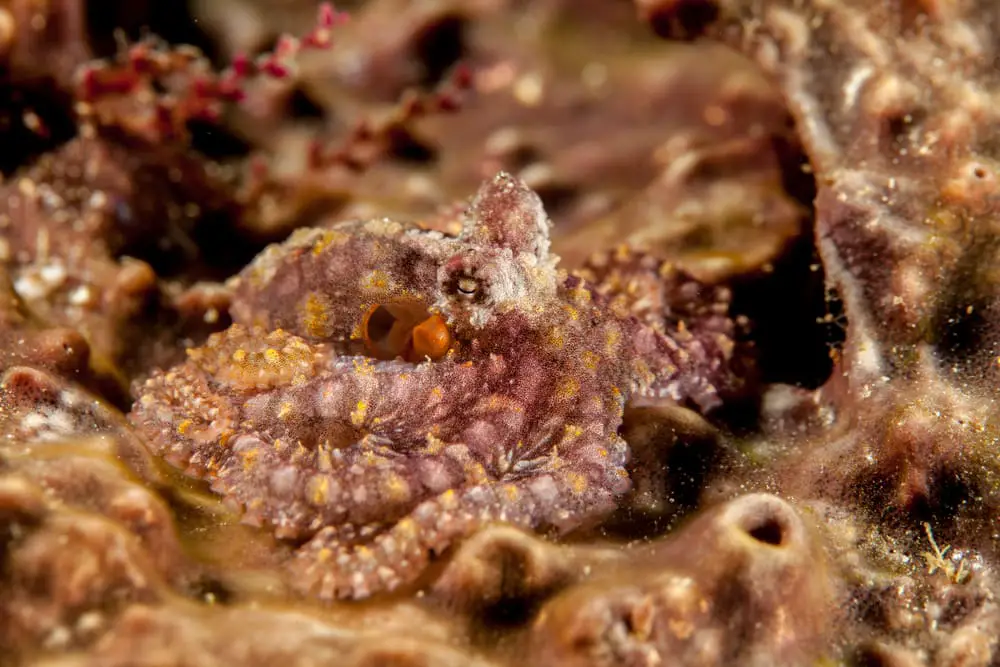
The Mosaic Octopus is a rare breed of octopus. They are part of the Incirrina sub-order and have the form of a typical octopus. The only difference is that this species has small reef-like spikes about its body.
Algae Octopus
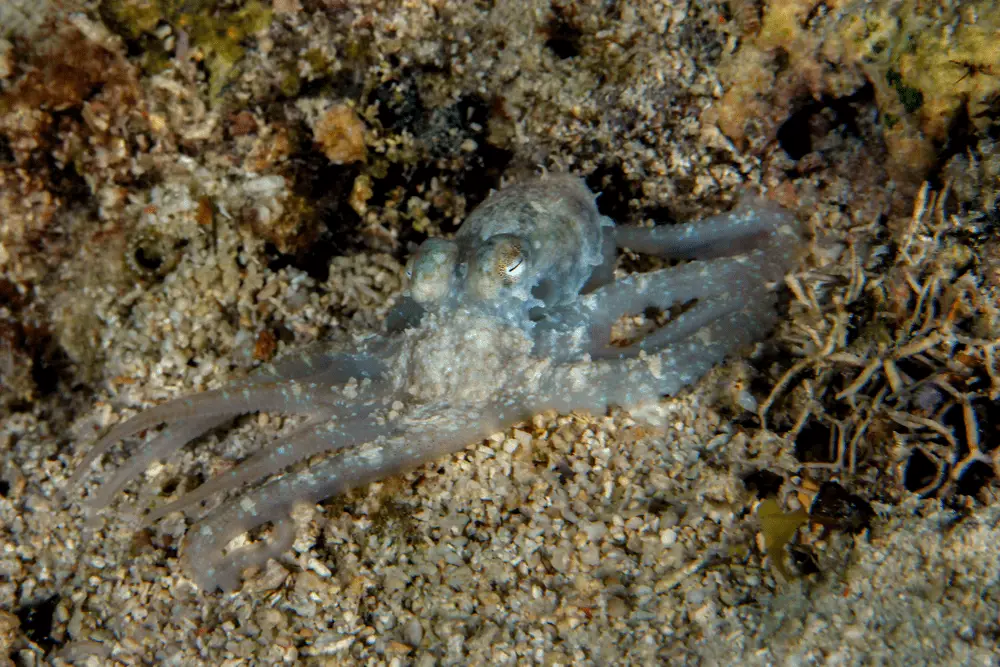
Abdopus aculeatus is a small octopus species that has the common name of algae octopus due to its typical resting camouflage, which resembles a gastropod shell overgrown with algae.
Sandbird Octopus

The Sandbird octopus (Octopus aegina) is found throughout the Indo-West Pacific coastal region, from Mozambique to the Red Sea and Japan. They are usually hunted for use in traditional cuisine. These octopuses get their common name since they inhabit muddy and sandy holes similar to the sand birds in the area.
Capricorn Octopus
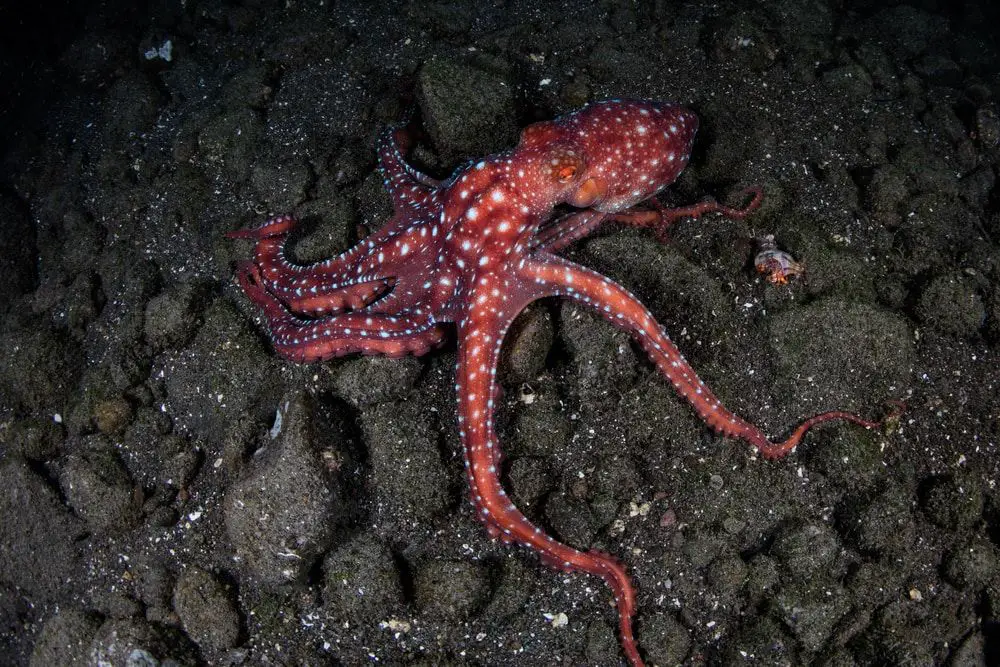
Capricorn octopuses are nocturnal which means that they are active during the night. They come out of their caves and crevices during the night so that they have less competition than they would during the day. They are also known as “night octopuses.”
Coconut Octopus
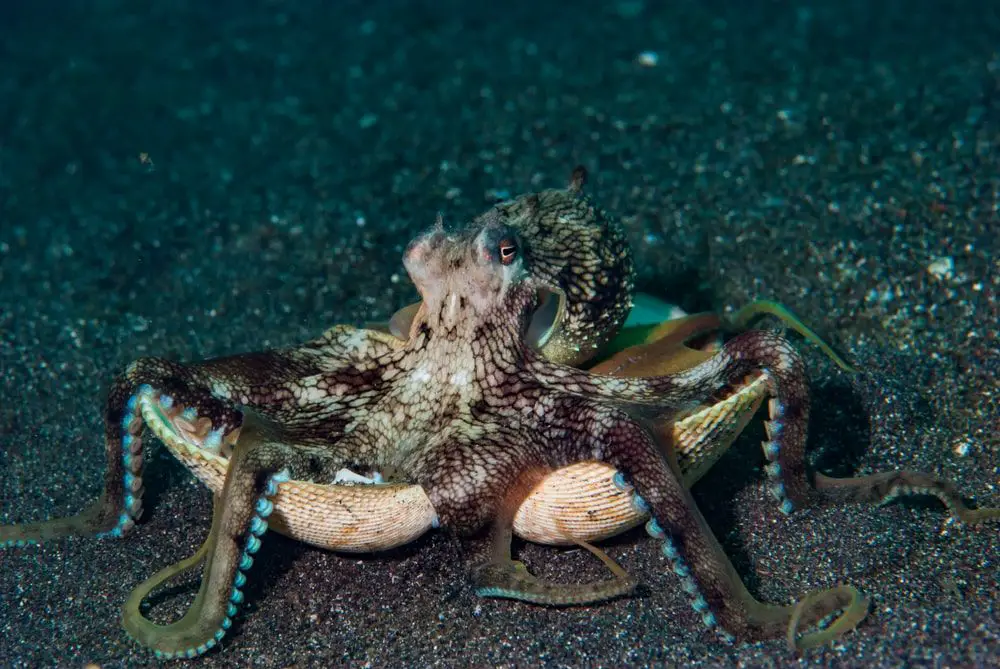
Amphioctopus marginatus, also known as the coconut octopus and veined octopus, is a medium-sized octopus species. They walk on the ocean floor using two legs while using the other legs to carry a coconut shell on their head.
Hammer Octopus

The common name – Hammer Octopus – refers to the large, club-like, modified arm tip found in mature males, which is primarily used in reproduction. Octopus australis has a sandy cream color and a skin ridge around its entire body, which helps it to bury itself in the sand
Southern Keeled Octopus
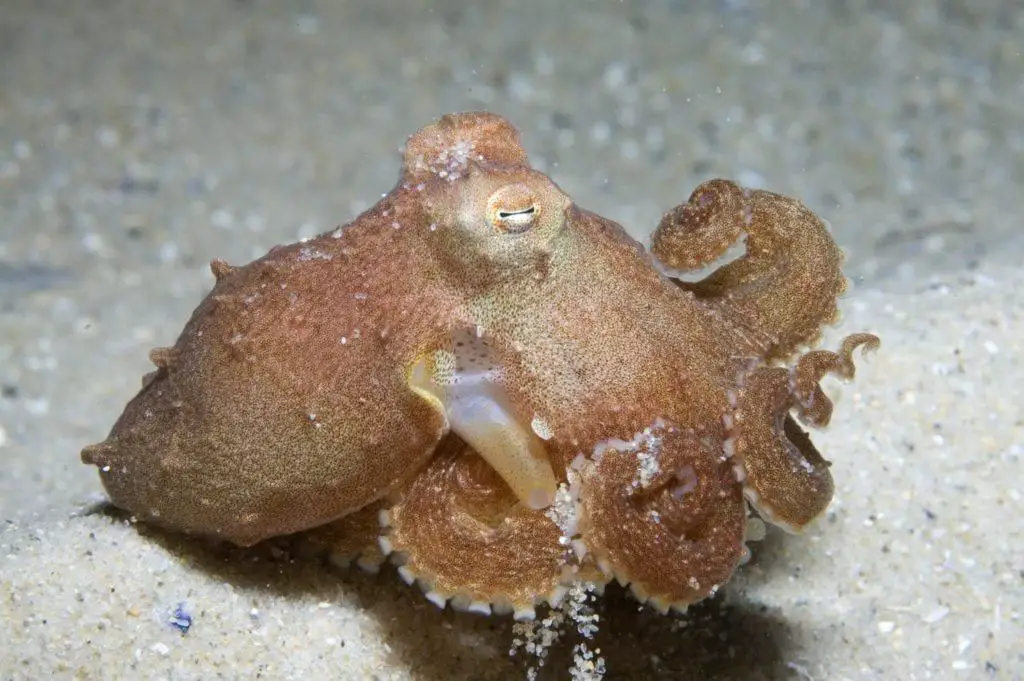
The Southern Keeled Octopus is common in shallow coastal waters of south-eastern Australia, although it is often confused with the morphologically similar Octopus australis.
Lilliput Longarm Octopus
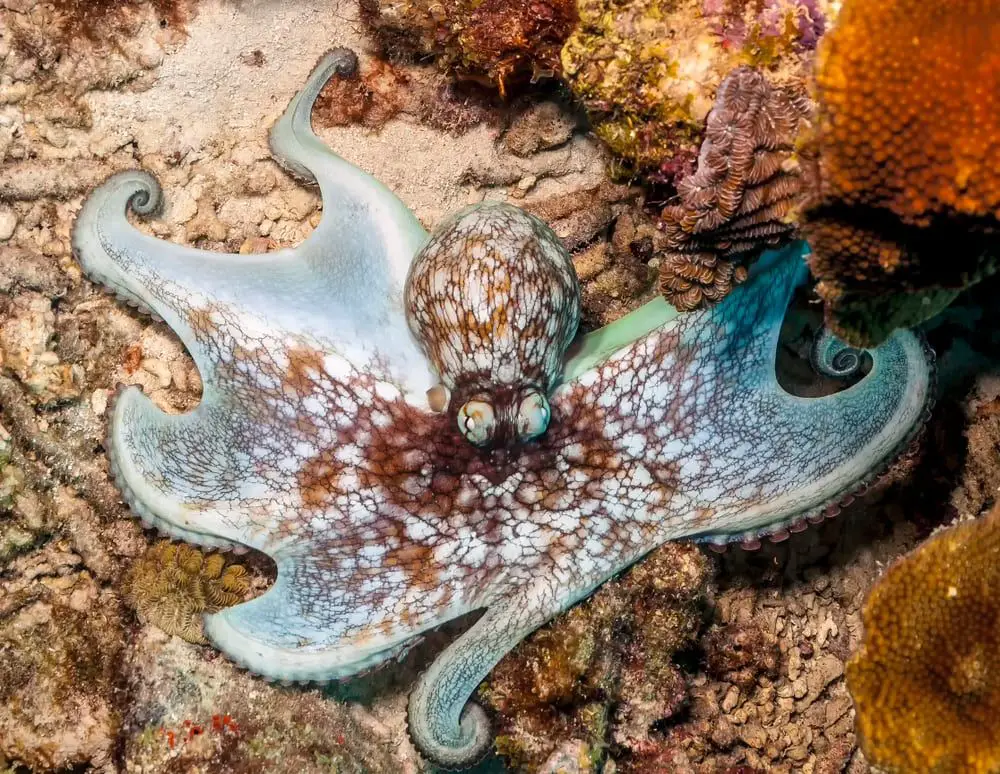
Macrotritopus defilippi, commonly known as the Lilliput longarm octopus or the Atlantic longarm octopus, is a small species of octopus that have e incredibly long arms that extend out much farther than the typical length of twice the head height.
Facts About Octopuses
- Octopuses do not live very long. Male octopuses die shortly after mating while females die shortly after the eggs hatch.
- Octopuses move in three ways: by walking across the ocean floor, by swimming using its tentacles, and by squirting water from a cavity to propel itself forward.
- Octopuses have three hearts. One heart pumps blood throughout the entire body of the octopus while the other two pump blood to the gills.
- Octopuses have blue blood.
References
- What Types of Different Octopuses Are There? – Reference
- Dumbo Octopus – Oceana
- Atlantic Pygmy Octopus (Video) – YouTube
- Atlantic pygmy octopus – Wikipedia
- Atlantic Pygmy Octopus – Octopus joubini – Octopus Worlds
- Blue-ringed octopus – Wikipedia
- Blue-ringed octopus flashing its bright warning colors (Video) – YouTube
- The Blue-Ringed Octopus: Small but Deadly – Ocean Conservancy
- California two-spot octopus – Wikipedia
- Video of California two-spot octopus, off Catalina Island Los Angeles – YouTube
- California Two-spot Octopus (Octopus bimaculoides) eggs hatching at low tide. (Video) – YouTube
- The octopus genome and the evolution of cephalopod neural and morphological novelties – Nature
- Caribbean reef octopus – Wikipedia
- Caribbean reef octopus inking (Video) – YouTube
- Caribbean reef octopus in camouflage (Video) – YouTube
- Caribbean reef octopus – Octopus Worlds
- Biology of the Octopus Briareus (Caribbean Reef Octopus) — Final Draft – Lindsey Duff for JR Science
- Common octopus – Wikipedia
- Common octopus exiting a hole in the ocean floor (Video) – YouTube
- Common Octopus – National Geographic
- Cephalopoda: An Overview (Book) Pg 4. – Google Books
- East Pacific red octopus – Wikipedia
- East Pacific Red Octopus (Octopus rubescens) (Video) – YouTube
- Red octopus – Monterrey Bay Aquarium
- Mimic octopus – Wikipedia
- The mating ritual of the mimic octopus (Video) – YouTube
- Mimic Octopuses, Thaumoctopus mimicus – Marine Bio
- The Indonesian mimic octopus (Video) – YouTube
- Giant Pacific octopus – Wikipedia
- Giant Pacific Octopuses are Extreme (Video) – YouTube
- Giant Pacific Octopus – National Geographic
- The Giant Pacific Octopus: Enteroctopus dofleini – Bioweb
- Seven-arm octopus – Wikipedia
- A sucker for jellyfish: The unexpected prey of the seven-arm octopus (Video) – Monterrey Bay Aquarium
- A giant deep-sea octopus is a sucker for jellies – Monterrey Bay Aquarium
- Rare Dumbo Octopus Shows Off for Deep-sea Submersible (Video) | National Geographic
- Dumbo Octopus Grimpoteuthis spp. – Oceana
- Blanket Octopus Facts and Info: These You May Not Have Heard Of – Animale Sake
- Rare ‘rainbow’ blanket octopuses caught on camera in the Philippines (Video) | USA TODAY
- The world’s weirdest octopus is a nautilus lookalike – and we’ve never seen so many (Video) – Earth Touch News
- Cirrata Grimpe, 1916 – Tree of Life
- Incirrata Grimpe, 1916 – Tree of Life
- Amazing Facts about Octopuses | OneKindPlanet Animal Education
- Types of Octopus – Sciencing
- 9 brains, 3 hearts: Some wild facts about octopuses | National Post
- WoRMS – Octopus abaculus Norman & Sweeney, 1997
| This Article Covers The Following Queries |
|---|
| types of octopus |
| types of octopuses |
| types of octopus species |
| octopus types |
| different types of octopus |
| kinds of octopus |
| octopus |
| different species of octopus |
| octopus breeds |
| different kinds of octopus |
